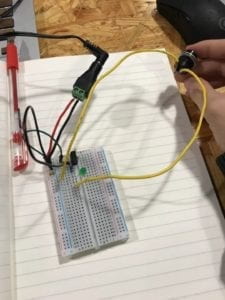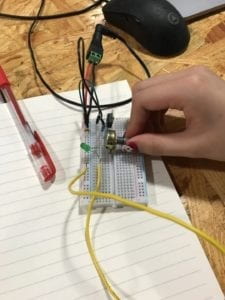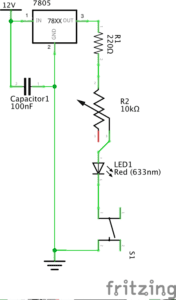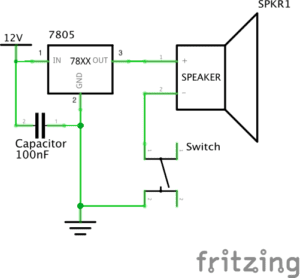Materials About Recitation
Our project is about building three circuits (Door Bell, Lamp, and Dimmable Lamp) on a breadboard based on the provided schematics. In my personal opinion, the goal of this project was making us understand the basic knowledge about simple circuit and how to use breadboard to connect different components. Below is my understanding of applications of each component. We used a Voltage Regulator to convert the Voltage of socket (220V) to 5V, which was the ideal voltage of our project and it could 12 volt power supply to give electricity power to our project. Buzzer and LED were the output interactions we want to see: if the Buzzer and LED worked, it showed that our projects were successful or not. Push-button Switch and Arcade Button were used to control our circuits. 220 Ohm Resistor was used to protect the circuits to make sure the voltage between components would not be too large. Variable Resistor was used to control the voltage between the two sides of LED in order to control the luminance of the LED. Multimeter was used to test all components’ parameters. At last, At last, the capacitor was designed to add capacitance to a circuit.
When we built the circuits, we had to understand the circuit diagrams first and then started at the positive side of the power supply. Then we connected all required components one by one. At last, we tested our circuits whether worked. In last recitation, we finished all the circuits required and all of them worked well.Below are three circuits we made.( Door Bell, Lamp, and Dimmable Lamp). The diagrams are at the end of documentation.
The door Bell circuit:

The Lamp circuit:

The Dimmable Lamp circuit:

During the process, we met three problems. The one was we did not pay attention to the instruction of the voltage regulator. We simply assumed that three legs of the regulator were the same. This problem made our first circuit failed. The second problem was that we could not use the breadboard neatly. We randomly chose two lines as the positive and the negative side of power supply and only used wires to connect different lines, which made our circuits a mess. The last one was that the circuit diagrams were different from the diagrams we learned in high school. So at the beginning, we tried hard to understand three diagrams. With the help of LAs and the study by ourselves, we solved these questions in recitation: we carefully read the instructions, learned to organize the breadboard by ourselves and drew new diagrams to help us understand the given diagrams.
Reflection on the questions
Question 1:
In the reading, it mentions that interaction is a cyclic process in which two actors alternately listen, think, and speak. In our projects, it was hard to said our circuits could “listen, think, and speak” because they were too simple. But I still think there was a simple interaction in our circuits. Image the user of out circuits does not know our circuits and he gives a input to our circuits: open the switch. As the feedback reaction, our circuits will have a LED on or a buzzer giving sound. It will also send message to user, although right now these messages are not meaningful. In my opinion, that giving our circuits a particular input and then they can give a simple output is the interaction of our projects.
Question2:
To answer this question, we need to know why we need interaction. And in Zack Lieberman’s video, he mentioned that we want to tough our “pain” or other emotions. So I guess that we need interactions to make connections from our mental world to physical world. Thus, Interaction Design and Physical Computing are used as a way to first understand people’s mind, such as allowing them to draw a picture and then to make their mind visible and touchable, such as people can play with the pictures they draw. These kind of arts can directly have effects on our mind. I think the technologies are the method to realize making connections and to draw a close relationship between mind and body is the way Interaction Design and Physical Computing be used to create Interactive Art.
The circuit diagrams:


